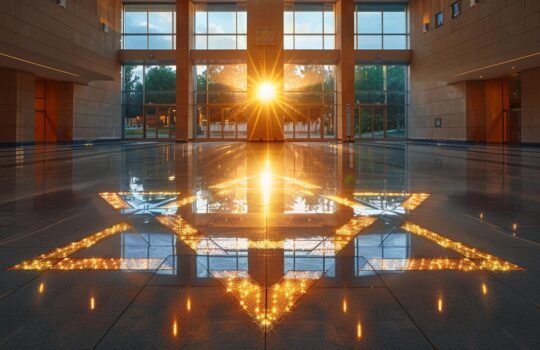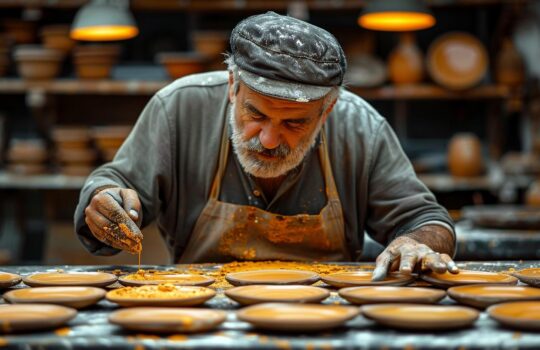How Traditional Jewish Symbols Influence Contemporary Art

Jewish symbols, rich in history and meaning, have long served as central elements of cultural expression within the Jewish community. These motifs are not merely relics of the past but continue to resonate with profound significance in the panorama of contemporary art. In this exploration, we delve into how the traditional icons of Jewish heritage-symbols that encapsulate spirituality, identity, and shared history-are influencing modern-day artists and becoming woven into the fabric of creative expression across various mediums.
The influence of Jewish symbols extends far beyond their religious roots; they emerge as powerful cultural emblems that carry a multitude of narratives and experiences within their designs. It’s these very symbols, like the Star of David or the Menorah, which serve as artistic inspirations while retaining their deep-seated roles within Jewish tradition. As bearers of such potent meanings, many contemporary artists draw upon these motifs to enrich their work with layers of cultural resonance.
Setting the stage for a thoughtful inquiry into this intersection between tradition and innovation, our discussion illuminates how traditional Jewish symbols transcend time by wielding their presence in today’s art scene. By examining both historical context and current reinterpretation, we gain insight into how these ancient markers are finding new life through contemporary creative lenses.
From canvas to digital landscapes, from sculpture to fashion-these symbols retain an immutable ability to inspire while simultaneously anchoring artists to their ancestral roots.
Historical Context of Jewish Symbols
Jewish symbols have long held profound significance within Jewish culture, serving as embodiments of faith, history, and identity. These emblematic icons are more than mere representations; they carry the weight of centuries of tradition and the collective memory of a people. Their presence in art is not just a nod to heritage but is often laden with layers of meaning that resonate deeply both within and beyond the Jewish community.
The Star of David
One of the most recognizable Jewish symbols is the Star of David-also known as the Shield of David or Magen David-a six-pointed star that has been associated with Judaism for centuries. Its origins are somewhat nebulous, with various theories suggesting it may have been used as an architectural ornament on synagogues as early as the 3rd century CE or adopted from medieval heraldry.
However, its widespread adoption in Jewish communities gained prominence during the 19th century when it began to symbolize Jewish emancipation and later became a key element in Zionism. Today, it prominently features on Israel’s flag and stands as a powerful symbol of Jewish identity.
The Menorah
The Menorah, another central icon in Jewish tradition, dates back to ancient times and was originally used in the Tabernacle set up by Moses in the wilderness and later in the Temple in Jerusalem. It is a seven-branched candelabrum that has become synonymous with Judaism’s eternal light-the enduring nature of faith even amidst darkness.
The Menorah’s design reflects detailed divine instructions outlined in biblical texts and has evolved into various artistic depictions over millennia. Each year during Hanukkah, Jews around the world light a variation known as the Hanukiah or Chanukiah to commemorate the rededication of the Second Temple.
Hamsa and Mezuzah
Other prominent jewish symbols include Hamsa-a palm-shaped amulet popularly used throughout North Africa and Middle East folklore-and believed to provide defense against negative forces. Though shared across different cultures, it holds unique connotations within Judaism like representing God’s protective hand and invoking Levantine aspects specific to Mizrahi customs.
The Mezuzah is also deeply embedded in daily life for many Jews. This small container affixed to doorposts contains parchments with verses from Deuteronomy inscribed upon them-including the Shema prayer-and functions as a constant reminder tenets central to Judaic faith while entering or exiting homes.
These jewish symbols collectively embody rich spiritual content while serving secular measures uniting distinct histories under common banners-one marked by stances resilient against upheaval through time immemorial until today’s dynamically charged art arenas employing these same enduring motifs for expressive pursuits spanning gamuts vast as human experience itself.
Jewish Symbols in Contemporary Art
Traditional Jewish symbols have long stood as beacons of identity and faith, transcending the boundaries between the sacred and the aesthetic. Their integration into contemporary art marks not only a cultural renaissance but also an exploration of personal and collective narratives deeply rooted in heritage. This resurgence reflects a growing interest amongst modern artists to both preserve and reinterpret cultural icons within their work, infusing it with layers of meaning that are at once ancient and strikingly relevant.
Artists Infusing Tradition With Innovation
The panorama of contemporary art is dotted with creative minds that draw upon the rich repository of Jewish symbols. Artists like Anish Kapoor, who, though not producing explicitly Jewish-themed art, reflects on his own heritage by exploring abstract forms reminiscent of traditional motifs.
Others, such as Mark Rothko, whose color field paintings evoke spiritual experiences akin to those found in religious contemplation – even though they do not depict recognizable symbols – suggest a connection to his Jewish identity. Then there are artists like Archie Rand, whose work directly integrates Hebrew text and imagery from Judaica, challenging both religious orthodoxy and artistic convention through bold storytelling canvases.
Reinterpretation in a Modern Context
Contemporary use of jewish symbols by artists often results in fresh interpretations that resonate with today’s audience while respecting the depth and sanctity behind these icons. The Star of David has been transformed from a religious symbol into a powerful motif for exploring themes related to genocide, memory, and resilience; consider Judy Chicago’s “Holocaust Project” which uses this symbol as a poignant reference point.

Furthering this transformative narrative is the work surrounding Menorahs: from architectural installations that play with light and shadow to graphic designs intertwining traditional lines with cutting-edge technology.
The Role in Identity Exploration
For many artists incorporating such symbolism into their creations represents more than mere homage; it is an intimate journey through their own sense of self and belonging. The Hamsa hand serves not just as protection against evil eyes but also allows for commentary on femininity and empowerment within contemporary society.
Similarly, Mezuzah cases are no longer limited to doorposts but find new life in jewelry design or sculptures-a blend between functional purpose dictionaries used daily life artifacts people interact yet still maintaining its sacral essence.
Through these works that integrate Jewish symbology’s aesthetics and ethos-whether subtly or overtly-contemporary art underscores its power to connect generations while elevating discourse around spirituality, remembrance, cultural identity, leading us towards an understanding where past influences present creativity flourishes unabated across diverse media channels.
The Impact of Jewish Symbols on Artistic Expression and Design
In the realm of contemporary art, Jewish symbols carry an aesthetic value that resonates deeply with both artists and audiences. The visual weight of symbols like the Star of David, or Magen David, with its interlocking triangles, provides a geometric elegance that can be used to dramatic effect in various art forms.
For instance, in graphic design, the clean lines and recognizable form offer a strong visual anchor that can be incorporated into logos, posters, and branding to convey a sense of heritage or identity. In fine art, such symbols may serve more nuanced purposes – as focal points for meditation on history and memory or as vessels for layers of added meaning through juxtaposition and context.
The adaptability and significance of these Jewish symbols also extend into other domains of creative expression. Fashion designers might embroider a Hamsa on garments as an amulet for protection or to invoke its roots in Middle Eastern culture.
Architects could integrate the shape of a Menorah into structural elements or decorative motifs within their buildings to imbue spaces with spiritual resonance or historical relevance. Similarly, digital media artists are finding innovative ways to incorporate jewish symbols into multimedia works by using them as thematic keystones around which narratives on diaspora experiences or cultural dialogues revolve.
Moreover, when examining the emotional depth conveyed through Jewish iconography in contemporary artwork, it is clear that these motifs often encapsulate complex stories and personal journeys into spirituality and self-discovery. Artists who tap into their ancestral lineage bring forward rich tapestries filled with jewish symbols that speak volumes about loss, triumph, hope, and resilience-each piece potentially acting as a microcosm for broader societal reflections or introspective pondering.
This powerful ability to embody intricate human emotions within simple outlines gives Jewish symbolism an influential role in artistic storytelling and depth creation within modern works spanning canvas to couture.
Addressing Challenges
The delicate balance involved in integrating cultural symbols into art without straying into cultural appropriation is a challenge that many contemporary artists face. Jewish symbols are rich with history and meaning, often open to interpretation but equally susceptible to being misunderstood or misrepresented. When artists use such emblems outside of their cultural or religious context, they risk diluting the symbol’s intended significance or inadvertently causing offense.
| Jewish Symbol | Common Misinterpretations |
|---|---|
| Star of David | Sometimes seen solely as a decorative motif, rather than a powerful emblem of Jewish identity and history. |
| Menorah | Occasionally misinterpreted as merely an exotic candelabrum, overlooking its religious and historical importance. |
| Hamsa | Frequently adopted in fashion without acknowledging its protective origins and spiritual connotations within Jewish culture. |
One way this misunderstanding manifests is through the appropriation of jewish symbols in fashion. For example, when non-Jewish designers incorporate the Star of David or Hamsa into clothing lines for aesthetic purposes alone, they run the risk of detaching these motifs from their profound roots in Jewish spirituality and communal identity.
Addressing these issues requires a nuanced approach where artists take time to educate themselves about the background and significance of any cultural elements they wish to include in their work. It is critical for creators who wish to engage with symbols not inherent to their own culture to do so with respect and awareness, thereby ensuring they honor rather than exploit the meanings behind these powerful tokens.
Respectfully representing Jewish symbols also involves recognizing the impact these depictions may have on Jewish communities. Misrepresentations can perpetuate stereotypes or spread misinformation about Jewish culture and beliefs.
Ensuring respect often involves consultation with members from the Jewish community or experts on Judaism who can provide insight into the proper use of such imagery. Outreach efforts not only prevent cultural insensitivity but also greatly enrich the artwork by imbuing it with authentic interpretations that resonate more deeply within both Jewish and broader audiences.

By actively engaging in dialogue around the origins, meanings, and contemporary applications of traditional tokens such as menorahs or mezuzot within creative works, artists contribute constructively towards multicultural understanding. Maintaining sensitivity towards these age-old emblems does more than protect against misappropriation; it preserves their integral role within living traditions while allowing them space to inspire new generations of artistic expression rooted in reverence for a rich cultural past.
Case Studies
Contemporary artists often seek to connect with their heritage through various mediums and themes. Among them, a number of creatives find inspiration in traditional Jewish symbols, utilizing them as central motifs within their artistic pieces. These artists draw upon the rich tapestry of Jewish culture, imbuing their work with symbolism that is both deeply personal and universally resonant.
- Mark Podwal – Known for his intricate drawings and paintings, Podwal often uses Jewish symbols like the Star of David or Hebrew letters to delve into themes pertaining to history and religion. His work not only reflects a profound understanding of Jewish folklore but also challenges viewers to consider contemporary issues through the lens of sacred imagery. For example, his series on Prague’s Altneuschul visually translates historical narratives using symbols that are pivotal within Judaism.
- Sigalit Landau – An Israeli artist whose installations often address social issues from a uniquely Jewish perspective. Through her artful submergence of objects in the Dead Sea waters, she allows salt crystals – a natural element evocative of purity in many traditions – to transform everyday items into stunning pieces suffused with meaning. With this method, objects adorned with traditional jewish symbols emerge encrusted in sparkling layers, generating dialogue about time, transformation, and perseverance.
- Helène Aylon – This feminist artist explores her own identity within Orthodox Judaism by creating provocative works that invite interpretation through the lens of gender as well as spirituality. Her “G-d Project” confronts patriarchal aspects within religious texts using biblical imagery alongside more general iconography associated with faith and skepticism. The integration of these elements challenges onlookers to re-examine preconceived notions about religion and women’s roles therein.
The utilization of Jewish icons extends beyond mere aesthetic inclusion; it shapes narrative context which adds emotional depth to artworks. By presenting familiar symbols in new lights or juxtaposing them against unexpected backdrops, these artists reimagine what these emblems signify in today’s world.
An exploration into how audiences receive such artistic endeavors reveals an appreciation for both the technical skill involved in incorporating Jewish symbols and the layers of meaning they introduce into each work. Critics often laud such art for its ability to communicate complex ideas while remaining accessible-a testament to the enduring power inherent within these age-old tokens when placed into capable hands.
Through linking past symbolisms with present realities, these case studies demonstrate that there is still much ground that can be covered by examining how traditional emblems like those originating from Jewish culture continue shaping expressions across diverse creative fields-from canvas-based artwork to multimedia installations-further emphasizing their impact on contemporary art forms.
Conclusion
As we have journeyed through the interwoven narratives of Jewish symbols and contemporary art, it becomes clear that these millennia-old emblems continue to hold a significant place within our current cultural landscape. The enduring relevance of Jewish symbols in art is a testament to their profound versatility and the deep-seated connection they offer to Jewish heritage.
These icons not only serve as gateways to understanding ancient traditions but also provide modern artists with a rich visual vocabulary that speaks boldly across time.
These traditional symbols, such as the Star of David and Menorah, carry with them centuries of historical significance; yet, they also act as beacons for new interpretations and artistic exploration. Modern-day creators have reinvigorated these jewish symbols, infusing contemporary themes and personal introspections while maintaining respect for their original meanings.
This fusion creates art that bridges the gap between past and present, allowing for a dialogue that resonates with both those well-versed in Jewish traditions and others who may be encountering them for the first time.
Conclusively, the tapestry woven by integrating Jewish symbolism into contemporary art is one rich with potentiality for continued conversation, creative innovation, and cultural reflection. Through embracing these powerful symbols within their work, artists open doors to deeper understanding while enriching the diversity of global visual culture.
As onlookers and appreciators of this union between tradition and modernity, we are invited to discover more creatives who champion this harmonious blend. Their artworks stand as profound testaments to the compatibility between aged rites and fresh perspectives-the capacity for Jewish symbols not only to endure but also inspire anew within our manifold world of artistic expression.
Frequently Asked Questions
What Are the 5 Main Symbols of Judaism?
Judaism is rich with symbols that hold significant meaning within the faith tradition. One of the essential symbols is the Star of David, a hexagram often associated with Jewish identity and community. The Menorah, a seven-branched candelabrum, represents knowledge and creation and is linked to the ancient Temple in Jerusalem.
The Torah, although not an iconographic symbol like others, represents Jewish law and teachings and thus holds a central place in Judaism’s symbolic world. Tefillin, small black boxes with straps contained within are parchment inscriptions of Torah verses, symbolize dedication to God’s commandments. Last but not least, the Mezuzah—a casing fixed to doorposts containing verses from the Torah—signifies Jewish faithfulness and divine protection over one’s home.

What Is the Most Powerful Jewish Symbol?
Determining the most powerful Jewish symbol can be subjective as it varies depending on personal or collective significance within different contexts or traditions. However, many regard the Star of David as highly powerful due to its recognition not only within Judaism but also globally as an emblem of the Jewish people and their heritage.
What Are the Three Jewish Symbols?
Three prominent Jewish symbols include the Star of David, which has become a universal representation of Judaism; the Menorah that signifies enlightenment and connection to divine worship; and lastly, Chai—which consists of two Hebrew letters that together mean ‘life’. These icons encapsulate various aspects of Jewish history, spirituality, and identity.
What Is the Jewish High Symbol?
Referring to what might be considered a high symbol in Judaism could imply discussing one that encompasses deep religious significance or holds a supreme position among other symbols used in rituals and practices.
In this context, the Torah stands out as it is revered as God’s direct teaching to Moses for B’nai Israel (the Children of Israel), playing a central role in virtually all aspects of observance.
What Is the 6 Symbol of Judaism?
Apart from some previously mentioned quintessential symbols such as the Star of David or Menorah amongst others, yet another symbol significant in Judaism is Chamsa (or Hamsa).
It’s traditionally viewed as an amulet for protection against evil eyes; this palm-shaped icon often contains an eye in its design illustration and can sometimes incorporate other Jewish motifs like fish or Hebrew letters too.
What Are the 3 Main Symbols of Christianity?
Christianity employs several dominant symbols with vast historical roots back to early Christianity times including Crucifix representing Jesus Christ’s sacrifice for human salvation; Ichthys or fish symbol which was initially secret shorthand among Christians under Roman Empire oppression; besides Alpha & Omega – first last Greek alphabet letters respectively signifying eternal nature deity Christ according God’s revelation Apostle John Book Revelation Bible text.
What Is the Judaism Symbol Christianity?
There isn’t any universally recognized single “Judaism Symbol Christianity” but instead there exists specific Christian symbolism extensively influenced by its Judaic heritage evidences particularly seen cross-shaped versions Jerusalem Cross—that combines Greek cross four Tau crosses around main centerpiece— this harmonizes sharing common Abrahamic lineage ancestral connections between both religions profoundly reflects profound synchrony contexts certain theological beliefs practices historical ties interwoven through centuries scholastic dialogues ecumenical movements across multifaceted interfaith landscapes nowadays globally alongside numerous shared liturgical expressions traditions much more far beyond mere superficial semblances united core monotheistic doctrine mono deity faithful adherence scriptural prominence foundational ethical moral guidelines embedded covenantal frameworks etcetera ad infinitum abiding spiritual kinship bond mutual respect appreciation respective distinct identities manifestations worship celebration rites rituals life cycle events cultural expressions etcetera.
What Are the Symbols and Colors of Judaism?
The colors most commonly associated with Judaism are blue and white mainly exemplified by Israeli flag featuring blue Star David on white background along blue stripes at top bottom edges simplistic color scheme resonates deeply themes purity heaven spiritual focus often notices accouterments ceremonial objects garments example tallit prayer shawl traditional adopted numerous occasions artifacts decor purposeful reflection values aspirations virtues engender faith communities individuals alike each color reflecting rays serenity divinity encapsulated tangible visual forms artistry craftsmanship spanning myriad creative outlets invoking age-old symbolism infused contemporary interpretations reverent artistic expressions transcribing pious dedication luminous aesthetic sensibilities imbued rich sacrosanct hues chromatic palette spiritual tapestry beliefs wisdom heritage customs narrating vibrant story intrinsic connection hue inflection pattern design medium messaging transcendental connection human soul majestic infinite creator universe timeless continuum reverence heeding call venerated elements structures foundational ethos elaborative synthesizing endlessly intricate elemental basics simple exquisite majesty beyond amalgamation undertones substance visible sight touch intertwined every fiber texture brushing strokes minimalist complex layered expressions depth nuanced understanding subliminal transcending space temporal confines enduring testament ethereal beauty unwavering light truth universal messages hope peace harmony inflection toward brighter future perpetuity epoch moments captured essence distilled essence echoed resonance reaching corners earth heavens unification hearts minds spirits pursuit quintessence sublime UNITY everything touching cornerstone converging paths journey destination entangled part social fabric weaved interactions experiences dialogues endless unfolding narrative woven golden threads existence principles guide navigational compass steer pathway celestial realms immaterial realms tangible realms collectively COMMUNITY singular entity ever-expanding cosmos seeking understanding continuous quest love mercy compassion justice freedom righteousness good kind acts enrich every step way diversified colorful mosaic celebrating grandeur diversity unity fascinating universe authored benevolent compassionate wise infinitely knowing Supreme Being ever-present constant change architectural choreography life crescendo ultimate revelation gloriously showcased through symbolic imageries living legacy potent signals rendered simply powerfully elegantly everlasting poignant reminders cherished hopes dreams aspirations humanity collective\uc0\u8232\uc0\u8232





